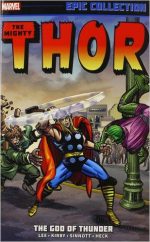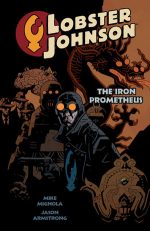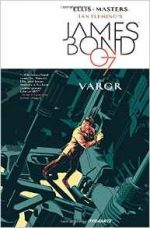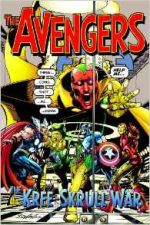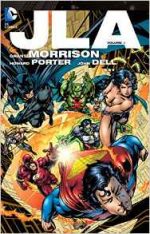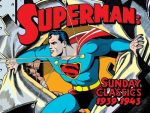
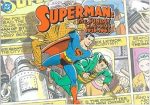
By Jerry Siegel & Joe Shuster & others (DC/Kitchen Sink Press: Sterling Publishing Co. Inc.)
ISBN: 9781402737862(Sterling)Â Â Â Â Â Â Â Â Â Â Â Â Â Â Â Â Â Â Â 978-1563894725(DC/KS)
It’s indisputable that the American comicbook industry – if it existed at all – would have been an utterly unrecognisable thing without Superman. Jerry Siegel & Joe Shuster’s unprecedented invention was rapturously adopted by a desperate and joy-starved generation, quite literally giving birth to a genre if not an actual art form.
Spawning an impossible army of imitators and variations within three years of his 1938 debut, the intoxicating blend of breakneck, breathtaking action and wish-fulfilment which epitomised the early Man of Tomorrow grew to encompass cops-and-robbers crime-busting, socially reforming dramas, science fiction, fantasy, whimsical comedy and, once the war in Europe and the East affected America, patriotic relevance for a host of gods, heroes and monsters, all dedicated to profit through exuberant, eye-popping excess and vigorous dashing derring-do.
In comicbook terms Superman was master of the world. Moreover, whilst transforming the shape of the fledgling funnybook industry, the Metropolis Marvel relentlessly expanded into all areas of the entertainment media. Although we all think of the Cleveland boys’ iconic invention as the epitome and acme of comicbook creation, the truth is that very soon after his debut in Action Comics #1, the Man of Steel became a fictional multimedia monolith in the same league as Popeye, Tarzan, Sherlock Holmes and Mickey Mouse.
We parochial and possessive comics fans too often regard our purest and most powerful icons in purely graphic narrative terms, but the likes of Batman, Spider-Man, The Avengers and their hyperkinetic kind long ago outgrew their four-colour origins and are now fully mythologized modern media creatures instantly familiar in mass markets, across all platforms and age ranges…
Far more people have seen or heard an actor as Superman than have ever read his comicbooks. The globally syndicated newspaper strips alone reached untold millions, and by the time his 20th anniversary rolled around at the very start of what we know as the Silver Age of Comics, Superman had become a thrice-weekly radio serial regular and starred in a series of astounding animated cartoons, two films, a TV series and a landmark novel by George Lowther.
He was a perennial sure-fire success for toy, game, puzzle and apparel manufacturers and had just ended that first smash live-action television presence. In his future were three more shows (Superboy, Lois & Clark and Smallville), a stage musical, a string of blockbuster movie franchises and an almost seamless succession of games, bubblegum cards and TV cartoons beginning with The New Adventures of Superman in 1966 and continuing ever since. Even his superdog Krypto got in on the small-screen act…
Although pretty much a spent force these days, for the majority of the last century the newspaper comic strip was the Holy Grail that all American cartoonists and graphic narrative storytellers hungered for. Syndicated across the country – and often the planet – it was seen by millions, if not billions, of readers and generally accepted as a more mature and sophisticated form of literature than comic-books. It also paid better.
And rightly so: some of the most enduring and entertaining characters and concepts of all time were created to lure readers from one particular paper to another and many of them grew to be part of a global culture.
Mutt and Jeff, Flash Gordon, Dick Tracy, Buck Rogers, Charlie Brown and so many more escaped their humble tawdry newsprint origins to become meta-real: existing in the minds of earthlings from Albuquerque to Zanzibar.
Most of them still do…
However it was considered something of a risky double-edged sword when a comicbook character became so popular that it swam against the tide (after all weren’t the funny-books invented just to reprint the strips in cheap accessible form?) to became a genuinely mass-entertainment syndicated serial strip.
Superman was the first comicbook star to make that leap – about six months after as he exploded out of Action Comics – with only a few ever successfully following. Wonder Woman, Batman (eventually) and groundbreaking teen icon Archie Andrews made the jump in the 1940s and only a handful like Spider-Man, Howard the Duck and Conan the Barbarian have done so since.
The daily Superman newspaper comic strip launched on 16th January 1939, supplemented by a full-colour Sunday page from November 5th of that year. Originally crafted by Siegel & Shuster – whose primary focus switched immediately from comicbooks to the more prestigious tabloid iteration -Â and their hand-picked studio (Paul Cassidy, Leo Nowak, Dennis Neville, John Sikela, Ed Dobrotka, Paul J. Lauretta & Wayne Boring), the mammoth daily grind soon required the additional talents of Jack Burnley and writers like Whitney Ellsworth, Jack Schiff & Alvin Schwartz.
This superb collection – doubly out-of-print despite its superb quality and sublime content – opens with an Introduction by occasional contemporary Super-Scribe Roger Stern, recapping the sensation and his creators, before stupendously re-presenting the first 19 complete tales of the primal powerhouse in stunning full colour.
Whether in pamphlet or local periodical, these tales of a modern Hercules exploded into the consciousness of the world. No one had ever seen a fictionalised hero throw all the rules of physics away and burst into unstoppable, improbable action on every page. In fact, editors and publishers’ greatest concern was that the implausible antics would turn off audiences. Clearly, they could not have been more wrong…
Thus most of the early episodes are about establishing the set-up of an Alien Wonder masquerading as an extremely puny human at a “great Metropolitan newspaper†whilst crushing evil as his flamboyant alter-ego. These stories are all about constant action and escalating spectacle, displaying the incredible power of the bombastic hero and man of the people…
On the first Sunday in November 1939 the parade of marvels commenced with a single introductory page describing Superman’s origins in ‘The Man of Tomorrow’ followed seven day later by initial adventure ‘Twenty-Four Hours to Ruin’ which found the Action Ace in a non-stop rush of blood and thunder whilst saving a logging concern from sabotage and hostile takeover by gangsters.
Crime segued into scientific fantasy as Superman encountered and saved ‘The Mindless Slaves of Dr. Grout’ from forced labour as the villain fomented a coup against America…
The inklings of true comicbook themes and more complex storylines arrived as Clark Kent and Lois Lane were despatched to investigate the ‘Giants of Doom Valley’: discovering a race of hostile subterranean invaders for Superman to discourage…
‘Assassins and Spies’ then took them into the most pressing concern of the era when agents of a foreign power began spreading sedition and terror on America’s shores to bolster a European war.
A mysterious mastermind used super-science, coercion, abduction and giant insects to ensure ‘The Chosen’ carried out his plans of global financial dominance before a more bucolic tale saw Superman helping Lois escape fatal consequences as ‘The Dangerous Inheritance’ left her with 5,000 acres of seemingly worthless scrubland…
Woe in the wilderness gives way to big city bombast as ‘The Bandit Robots of Metropolis’ cause carnage in search of cash, pushing the Man of Steel to his physical and intellectual limits and priming him for a landmark clash against ‘Luthor, Master of Evil’ who turns the weather into a weapon in his ongoing war against mankind.
A cunning murderer attempts to frame a professional automobile driver in ‘Death Race’ whilst a high-tech propaganda campaign seeks to destabilise the city when ‘The Committee for a New Order’ begins pirating the airwaves. As Superman crushes their campaign of terror he is embroiled in a blistering battle against vile enemy agents who know Lois is his Achilles Heel…
Another corporate assault on trade is exposed when freight drivers are poisoned by crooks whose orders are to ‘Destroy All Trucks’ of a businessman’s rivals, before a mirage-making super-villain pillages Metropolis until her galvanic guardian see through ‘The Image’…
When Clark’s ‘Arson Evidence’ convicts an innocent man, his other self moves heaven and earth to exonerate the jailbird and ferret out the true fire-fiend after which – it being almost three years since his debut – Superman spent two weeks reminding old readers and informing new ones why and how he was ‘The Champion of Democracy’.
To a large extent mention of World War II was kept to a minimum on the Action Ace’s funny pages, but now ‘The Superman Truck’ – detailing how a formidable prototype military transport was relentlessly targeted by saboteurs – jumped right in with a subplot about a reluctant taxi driver enlisting in Army Transport Corps.
Tracing his induction and training, this yarn was a cunningly-conceived weekly ad and plea for appropriately patriotic readers to enlist…
Military motifs continued as a ship full of diplomats and war correspondents is set afire by an incendiary madman allied to in-over-their-heads Fifth Columnists. It’s not long before ‘The Blaze’ is in critical timberland, acting on his own deranged impulses and leaving Superman a huge job to save America’s war effort…
Showbiz raised its glamorous head when Clark and Lois were sent to cover the morale-boosting ‘Hollywood Victory Caravan’ tour, only to stumble into backbiting, sabotage, intrigue and murder at the hands of Nazi infiltrators.
Wrapping up the vintage spills and thrills is another fervent comics call to arms as Superman and Clark take a well-intentioned but lazy and perpetually backsliding wastrel in hand, shepherding him through aviator ‘Cadet Training’ to a useful existence as a warrior of Democracy…
Supplementing the gloriously rip-roaring, pell-mell adventure are spellbinding extra features including ‘How Superman Would End World War II’ (first seen in the February 27th 1940 issue of mainstream icon Look magazine), ads and a 1942 ‘Superman Pinup’.
This specific Sterling Publishing volume is a reissue of the 1999 DC/ Kitchen Sink co-production, but either edition offers timeless wonders and mesmerising excitement for lovers of action and fantasy. If you love the era or just crave simpler stories from less angst-wracked times these yarns are perfect comics reading, so this a book you simply must have…
Superman and all related names, characters and elements are ™ DC Comics © 2006. All rights reserved.


